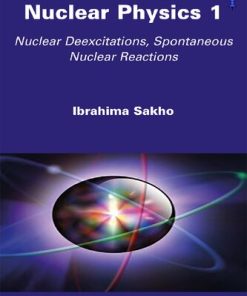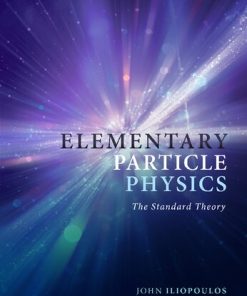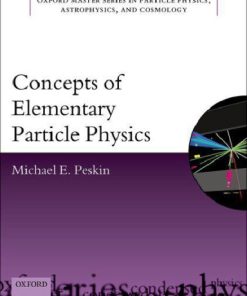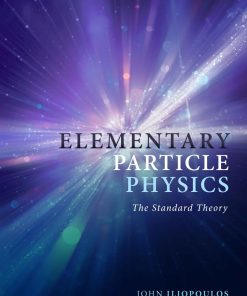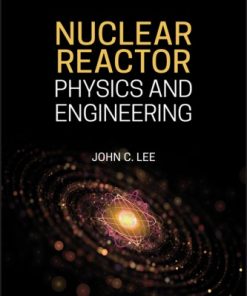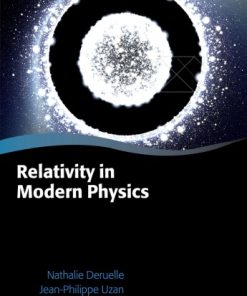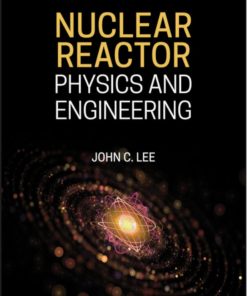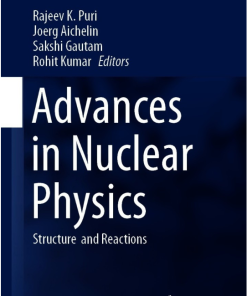A Modern Primer in Particle and Nuclear Physics 1st edition by Francesco Terranova 0192660046 9780192660046
$50.00 Original price was: $50.00.$25.00Current price is: $25.00.
A Modern Primer in Particle and Nuclear Physics 1st edition by Francesco Terranova – Ebook PDF Instant Download/DeliveryISBN: 0192660046, 9780192660046
Full download A Modern Primer in Particle and Nuclear Physics 1st edition after payment.

Product details:
ISBN-10 : 0192660046
ISBN-13 : 9780192660046
Author: Francesco Terranova
A Modern Primer in Particle and Nuclear Physics provides a cohesive introduction to the fundamentals of the field and is designed to be accessible to undergraduate students. The textbook provides an ideal entry point and presents the modern concepts, theories, and experiments that explain the elementary constituents and basic forces of the universe. Starting with the basic concepts and definitions, the textbook goes on to cover core developments, such as the links between quantum chromodynamics and nuclear physics, the Higgs Boson, and the first observation of gravitational waves. New concepts are introduced gradually and clarified by intuitive explanations, exercises, and concrete examples linking particle physics to nuclear physics, astrophysics, and gravitation. The book also includes appendices on special relativity and non-relativistic quantum mechanics for those needing a basic grounding in these areas. The text is an expert guide for undergraduate physics students wanting to expand their knowledge, and also provides fascinating insights to graduate students, junior researchers, and physics enthusiasts.
A Modern Primer in Particle and Nuclear Physics 1st Table of contents:
1 Setting the scene
1.1 The dawn of particle physics
1.2 Elementary particles
1.3 Forces, potentials, and fields
1.4 The elementary particles of the Standard Model
1.4.1 Leptons
1.4.2 Quarks
1.4.3 Antiparticles
1.4.4 Elementary bosons and fundamental interactions
1.4.5 The Higgs boson
1.5 Natural units
1.5.1 Metric systems
1.5.2 Natural systems of units
1.5.3 Conversion rules
Further reading
Exercises
2 Scattering and decay
2.1 Covariance
2.1.1 Covariant and contravariant quantities
2.1.2 Classification of covariant objects
2.2 Particles in space-time
2.2.1 The Minkowski space-time
2.2.2 Notations for special relativity
2.3 Kinematical constrains
2.3.1 Physical laws and covariance
2.3.2 One particle kinematics
2.3.3 A note on the Einstein energy–mass relation*
2.4 Decays and two-particle kinematics
2.5 Three-body decays
2.6 Decay amplitudes in quantum mechanics
2.6.1 The Fermi golden rule
2.6.2 Phase-space of the decays*
2.6.3 Lifetimes and branching ratios
2.6.4 Unstable states
2.7 Scattering
2.7.1 Fixed-target collisions
2.7.2 Colliding beams
2.8 Scattering in quantum mechanics
2.8.1 Flux
2.8.2 Cross-sections and Lorentz invariance
Exercises
3 Measurements in particle physics
3.1 Heavy charged particles
3.2 Energy loss of electrons
3.3 The discovery of antimatter
3.4 Interaction of photons with matter
3.4.1 Photoelectric effect
3.4.2 Compton scattering
3.4.3 Pair production
3.5 The simplest particle detector
3.6 Detector technologies
3.7 Gaseous detectors
3.7.1 Energy resolution
3.7.2 Geiger–Müller counters
3.8 Detection of photons
3.8.1 Compton scattering and pair production
3.8.2 High-energy photons and calorimeters
3.9 Physical measurements*
3.10 Tracking particles
3.10.1 Precise reconstruction of trajectories
3.10.2 Tracking detectors
3.11 Simulating detectors
Further reading
Exercises
4 Accelerators and colliders
4.1 Particle accelerators
4.2 Static accelerators
4.2.1 The Greinacher voltage rectifier
4.2.2 Voltage doubler
4.2.3 The Cockcroft–Walton accelerators
4.3 Linear accelerators and the phase stability principle
4.3.1 Veksler–McMillan stability
4.3.2 High-energy LINACS
4.4 Synchrotrons
4.4.1 The components of a synchrotron
4.4.2 Phase stability in synchrotrons
4.4.3 Weak and strong focusing*
4.4.4 Emittance
4.5 Colliders
4.6 Detecting particles at colliders
4.6.1 Triggering a particle detector
4.6.2 Detecting jets
4.6.3 Hadron calorimeters
4.6.4 Particle identification
4.7 Novel acceleration techniques*
Further reading
Exercises
5 Symmetries and anti-matter
5.1 Symmetries and non-integrable systems
5.2 Symmetries in quantum mechanics
5.3 Classification of symmetries
5.4 Translations and rotations in quantum mechanics
5.4.1 The first Noether theorem*
5.5 Inversions
5.5.1 Parity
5.5.2 Additive and multiplicative quantities*
5.6 The intrinsic parity of the particles
5.6.1 The parity of the photon
5.6.2 The Chinowsky–Steinberger experiment
5.6.3 Intrinsic parity of the elementary fermions
5.6.4 The intrinsic parity of composite states
5.6.5 The parity of the elementary bosons*
5.7 C-parity
5.7.1 Classical C-parity
5.7.2 The C-parity of particles
5.7.3 Particle–antiparticle pairs
5.8 T-parity and the CPT theorem
5.8.1 Time-reversal
5.8.2 The CPT theorem
5.9 The Dirac equation
5.9.1 Solutions of the Dirac equation
5.10 What is a spinor?*
Further reading
Exercises
6 Electromagnetic interactions
6.1 Classical electrodynamics and relativity
6.2 Classical gauge transformations
6.3 Particle Hamiltonian in an e.m. field*
6.4 Gauge transformations in non-relativistic quantum mechanics*
6.5 Gauge theories
6.5.1 Gauge symmetries
6.5.2 The gauge principle
6.6 Quantum electrodynamics
6.6.1 The simplest QED process
6.6.2 The photon in QED
6.6.3 Higher-order diagrams
6.7 Positronium
6.8 The e+e- cross-section
6.9 The running of α
Exercises
7 The modern theory of strong interactions
7.1 Introduction
7.2 Quarks
7.3 The charges of the strong interactions
7.4 Color symmetry
7.5 Representations of continuous groups
7.6 Quantum chromodynamics
7.6.1 The Feynman diagrams of QCD
7.6.2 Scattering of quarks
7.6.3 The gluon*
7.6.4 Asymptotic freedom
7.7 Do quarks exist?*
7.8 Jets and QCD predictions
7.8.1 Spatial distribution of hadrons
7.8.2 The spin of the gluon
7.8.3 Modern techniques
Exercises
8 Flavor symmetries and the quark models
8.1 Hadrons
8.2 Classification of stationary states in atomic physics
8.2.1 A glimpse of group representation theory*
8.3 Baryons in the two-quark model
8.3.1 Physical states
8.4 The discovery of the Δ (1232)
8.5 The origin of hadron masses*
8.6 The three-quark model
8.6.1 Parity and excited states
8.7 Mesons in the two- and three-quark models
8.7.1 Discrete symmetries of mesons
8.7.2 Limitations of the quark model*
8.8 The heritage of the past
8.9 Generalization of the quark model
Further reading
Exercises
9 From QCD to nuclear physics
9.1 The discovery of the neutron
9.2 Nuclei
9.3 NN states and the deuteron
9.3.1 Spin and parity of the deuteron
9.4 Multi-body nuclides
9.4.1 The shell model
9.4.2 Mean potential of the shell model
9.4.3 Classification of nuclides in the shell model
9.4.4 Spin and parity
9.4.5 Island of stability
9.5 The mass of the nuclides
9.5.1 The SEMF
9.5.2 Fermi gas model and the pairing term of the SEMF
9.6 The QCD origin of nuclear mass
9.6.1 Isospin in nuclear physics
9.6.2 Isomultiplets and the mass of nuclei
9.6.3 Modern techniques*
9.7 Kinematics of nuclear reactions
9.8 Fission reactions
9.8.1 Fission of uranium
9.8.2 Nuclear reactors
9.8.3 Fission-based nuclear weapons
Further reading
Exercises
10 Weak interactions
10.1 Spotting weak processes
10.2 Classification of weak interactions
10.3 Neutrino flavors
10.4 Conservation laws and symmetries of weak interactions
10.4.1 Baryon number
10.4.2 Lepton number
10.4.3 Lepton family number
10.5 Parity violation
10.5.1 Chiral theories
10.5.2 Chirality
10.5.3 The experiment of Chien-Shiung Wu
10.5.4 Experimental evidence of P-violation
10.5.5 Cooling at 10 mK*
10.6 The chirality of neutrinos
10.6.1 Electron capture and photon re-absorption
10.6.2 The Goldhaber experiment
10.7 The V-A theory
10.7.1 Parity in vector and axial couplings*
10.7.2 From the Fermi to the V-A theory
Exercises
11 Radioactivity and cosmic engines
11.1 Radioactive decays
11.2 Decay chains
11.2.1 Bateman equations*
11.2.2 14C and the radiocarbon revolution
11.3 Alpha decays
11.3.1 Decay thresholds
11.3.2 The quantum mechanics of alpha decays
11.3.3 Selection rules
11.4 Beta decays
11.4.1 Kinematics of beta decays
11.4.2 The electron spectrum and the neutrino mass
11.4.3 Classification of beta decays
11.4.4 Allowed transitions
11.4.5 Forbidden and superallowed transitions
11.4.6 A fresh look at GT transitions
11.4.7 Selection rules for beta decays
11.5 Majorana neutrinos
11.6 Gamma decays
11.6.1 Classical and semiclassical theory
11.6.2 Selection rules
11.6.3 Gamma spectroscopy and the Mössbauer effect
11.7 Natural radioactivity
11.8 Cosmic power sources
11.8.1 Nuclear fusion
11.8.2 Fusion reactors and weapons
11.9 The lifecycle of a star
11.10 Supernovas and cosmic rays
11.11 Muons, pions, and the Yukawa meson*
Further reading
Exercises
12 The electroweak theory
12.1 Weak interactions in the 1960s
12.2 The electroweak theory
12.2.1 SU(2) × U(1) gauge symmetry
12.2.2 Field mixing
12.3 Feynman diagrams of the electroweak theory
12.3.1 W+ and W- fields
12.3.2 Neutral fields
12.4 The discovery of weak neutral currents
12.5 The discovery of the Z0
12.6 The discovery of the W bosons
12.7 Precision electroweak physics and N
Exercises
13 At the forefront of the Standard Model
13.1 The Higgs mechanism
13.1.1 Relativistic fields
13.1.2 Spontaneous symmetry breaking
13.1.3 The appearance of the remnant field
13.2 Higgs in the electroweak theory
13.3 Fermion masses
13.4 The Standard Model of particle physics
13.5 The discovery of the Higgs boson
13.6 The Yukawa sector of the Standard Model: leptons
13.6.1 Cherenkov light
13.6.2 The discovery of neutrino oscillations
13.6.3 Leptonic Yukawa Lagrangian and mixing matrices
13.6.4 The PMNS mixing matrix*
13.6.5 Effective neutrino masses
13.7 The Yukawa sector of the Standard Model: quarks and CP violation
13.7.1 CP violation
13.7.2 Meson oscillations
13.7.3 B mesons
13.8 Light and shadow of the Standard Model*
13.9 Particle physics and cosmology
13.10 Natural dark matter
13.11 The discovery of gravitational waves
13.11.1 Waves in GR
13.11.2 Gravitational interferometers
13.11.3 Multimessenger astronomy
Further reading
Exercises
A Special relativity
A.1 What is relative in relativity?
A.2 Consequences of the universal speed c
A.2.1 Time dilation
A.2.2 Length contraction
A.3 Relativistic dynamics*
A.4 Newton’s laws of motion in SR
A.5 Relativistic and non-relativistic particles
A.6 Relativistic Doppler effect
A.7 Special and general relativity*
B The principles of quantum mechanics
B.1 States
B.1.1 Bra-ket notation
B.2 Observables
B.2.1 Angular momentum and spin
B.2.2 The Dirac delta function
B.3 Time evolution of quantum states
B.4 Measurements and the uncertainty principle
B.5 The Dyson series*
People also search for A Modern Primer in Particle and Nuclear Physics 1st:
terranova a modern primer in particle and nuclear physics
f.terranova. a modern primer in particle and nuclear physics
a modern primer in particle and nuclear physics pdf
a modern primer in particle and nuclear physics francesco terranova
a modern primer in particle and nuclear physics solutions
Tags: A Modern Primer, Particle, Nuclear Physics, Francesco Terranova, cohesive introduction
You may also like…
Physics Physics - Quantum Physics
Physics - Others
Elementary Particle Physics: The Standard Theory by John Iliopoulos
Physics - Theory of Relativity and Gravitation




